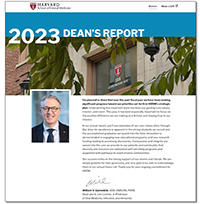
Ultrasonography—a technique that uses echoes of ultrasound pulses to delineate objects or areas of different density in the body—has been used for many years in medicine, from monitoring babies in the womb to detecting gallbladder disease, however ultrasonography’s use in dentistry is still somewhat new. The development of a small ultrasound probe that fits in the mouth has been a gamechanger in discovering new intraoral uses for ultrasonography.
“It’s become the gold standard for evaluating soft tissue around teeth and dental implants in a very precise and non-invasive way,” said Dr. Lorenzo Tavelli, assistant professor in the Division of Periodontology, Department of Oral Medicine, Infection, and Immunity at HSDM.
“In the case of dental implants, it allows for a better picture of what is happening beneath the surface,” he said. “It can be used over the course of healing to visualize blood flow, measure tissue growth, and detect inflammation—all without radiation. I’m able to say, ‘this implant is healthy’ much more definitively.”

Tavelli has been introducing the technology to dental students and residents and is overseeing three advanced graduate student research projects using ultrasonography. While there is a learning curve to operate the probe and interpret the real-time images on the screen, he sees the opportunity to demonstrate the precision it can give a clinician in producing optimal results for the patient.
“With ultrasonography, it enables us to see beyond what we could with other technologies and more precisely measure results before and after procedures,” Tavelli said.
Periodontology resident David Wu, DMSc23, has had a chance to work with the technology under Tavelli’s supervision to perform assessments of patients’ periodontal tissue health.

Tavelli recently received pilot grant funding for ultrasonography equipment to study and advance the understanding of peri-implant health and wound healing following soft tissue grafting at implant sites. He was also awarded funding from the Osseointegration Foundation for the project “Predisposing and Protective Factors for Implant Health Complications and Esthetic Success: A Clinical and Ultrasonographic Study,” which was selected as the Foundation’s 2022 Translational and Clinical Science Research Grant winner. The objective of the study is to combine the use of novel Power Doppler Ultrasonography to clinical and radiographic parameters for characterizing dental implants and assessing parameters associated with esthetic outcomes, peri-implant health, and complications.
“It’s very important to study the course of healing, and inflammation resolution,” Tavelli said. “Being able to do this without radiation offers a minimally-invasive way that is much more patient-oriented.”


